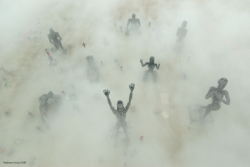(In 2009 I wrote a two-week series of blog posts about post-apocalyptic novels & films for Borders’ blog. Because this subgenre has continued to flourish, I am reprinting the posts here.)

I grew up in the shadow of mushroom clouds. If you’re under 30, it may be difficult to understand how inevitable nuclear annihilation seemed back then. We were sleeping in the atomic bed our parents had made in World War II, our dreams invaded by visions of sudden light and inescapable heat. Social theorists and psychologists offered explanations and hypotheses, but the obvious one never seemed to be proffered: The bombs were real. The missiles in their silos were real. We weren’t making this crap up. They were aimed at us, and within them slept annihilation forged by our own minds yet paradoxically inconceivable.
Then the Cold War receded and the world went online. Geographic borders became less relevant; multiculturalism became the watchword of the nascent global village. Sudden light and inescapable heat no longer usurped our dreams.
Then began a series of events that worked their way into the public consciousness. The comet Shoemaker-Levy strafed Jupiter and the public was made viscerally aware that there but for the grace of god and an accident of orbital mechanics go us. Paleontologists and geologists began proving that extraterrestrial strikes hadn’t just wiped out the dinosaurs, they’d wiped out damn near everything — and more than a few times, too. NASA’s Near Earth Object Program has catalogued some 5,500 proximate orbiting objects, 1,000 of which represent a genuine threat. We may have got this far by simple virtue of being sandwiched between falling rocks.
Meantime epidemiologists realized humanity was overdue for a global pandemic, probably a mutated flu strain. The influenza pandemic of 1918 killed at least 50 million people (100 million, by some estimates) — in an age far less accustomed to readily available international travel.
And is it hot in here, or is it just us? The Northwest Passage opened up for the first time in recorded history. Sea levels rose. Species began migrating toward the equator. Extinction rates increased — not all of them due to climate change, either. Humanity’s very biomass was affecting the planet. The amount of grain it takes to feed the cows that feed us affects the food chain, the landscape, the atmosphere. People started buying electric cars as some kind of Band-Aid and blithely ignored the fact that most electricity is produced by burning coal (fossil fuel takes on a whole new meaning now, dunnit?).
And for the first time in human history more people lived in cities than out of them. Emergent digital infrastructures began migrating not only information but culture itself to a form that depended entirely upon an interdependent foundation of technological sophistication: Digital media and the Internet.
Things were looking kind of frail.
Only a generation ago our biggest worry was blowing ourselves up. Now we have evidence from a number of disparate sources that this fear is really a kind of hubris, a form of self importance. Because we can survive our technological and sociological adolescence and the universe can still smoosh us like a tick at any time. Big rocks from space can smash our little anthill. Gamma radiation from a sun that went supernova about the time the Visigoths were knocking at Rome’s door can sleet through us and end our overpopulation worries in a couple of generations. Free-riding viruses treat us as public transportation and discard their vehicles when they’re done with them. Solar flares can swing for the centerfield wall. The planet itself can run a fever and send us packing.
And we might make such cosmic worries moot with our own two hands, because it’s possible we’ve gotten too smart for our own good — what a friend of mine calls Monkey with a Gun. One hiccup on a gene-slice alteration can uncoil a billion years of DNA. One glitch in a nanobot can run rampant through the species. The torch we pass now runs on electricity. Civilization is built on quicksand. Humanity is a house of cards. I believe its increasing interconnectedness and interdependence is almost entirely good for it (though ultimately worrisome for independent cultural survival), because it allows us to build up survivable resistance in ways far beyond those that defeat mere bacteria. I also think it’s gonna be a photo finish however it turns out.
Artists and opportunists, preachers and con men, futurists and fabulists, entertainers and infomercials have surveyed this ripe and artificed terrain and asked themselves, What if all this stops? Do we eat, drink, and make merry? Do we survive? How? Does our planet survive us even if we do? Or is the end of much of life on earth the price we pay for monomaniacal evolutionary success? How can we flourish without destroying what surrounds us? Because our very success is a kind of catastrophe in the making. A slow-motion apocalypse.
We are a worried people dreaming out loud. We buy our dreams of heat and light. We go to bookstores. We go to theaters. These are our training manuals. Our collective rehearsals. In silent witness we practice our emergency preparedness drills. There is our reality-testing. There indeed may be our reality itself.
A Buddhist maxim says to live your life as if you are already dead. Perhaps our civilization is in the throes of learning that as well.